Learn how to make a potato flake sourdough starter. Made with sugar, dehydrated potatoes, and yeast, you can make delicious sandwich bread with a much sweeter taste than its typical sourdough counterpart.
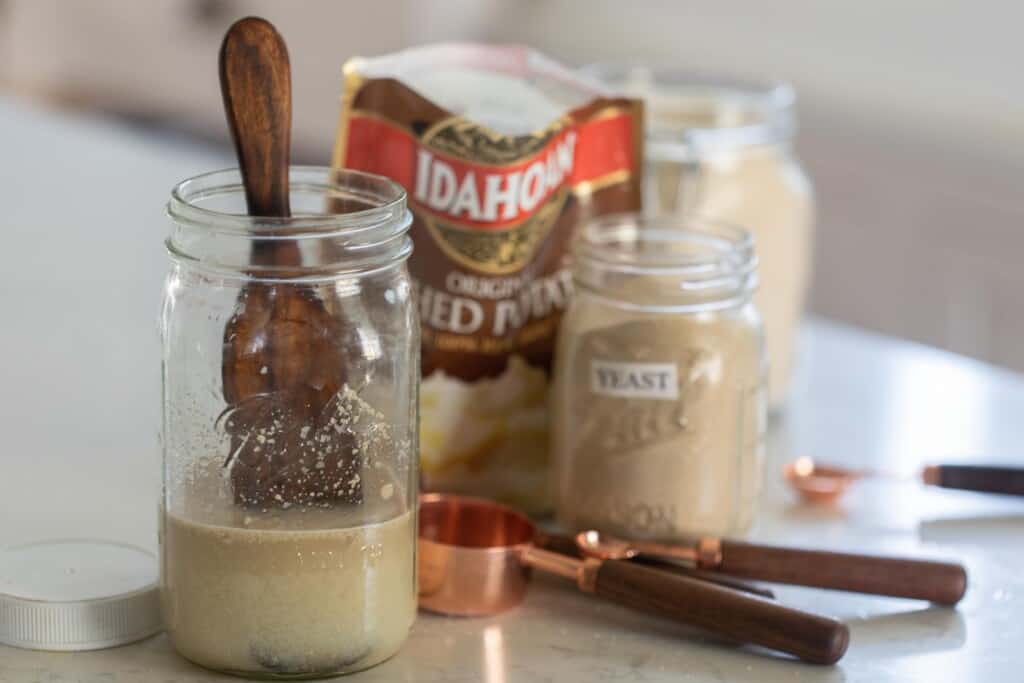
Table of Contents
- What is a potato flake sourdough starter?
- Why you’ll want a potato flake sourdough starter
- Tips for a sourdough bread starter with potato flakes
- FAQ
- Potato Flake Starter Ingredients
- How to make a potato flake sourdough starter
- How to maintain a potato flake sourdough starter
- Step-by-step instructions for maintaining your starter
- How to use your potato flake sourdough starter to make bread
- Directions:
- Check out more sourdough resources and recipes!
- Potato Flake Sourdough Starter Recipe
You know how much I love homemade sourdough bread. Sometimes, though, I do crave a sweeter bread with a little less of that signature sourdough tang and sourness.
I rarely make yeast breads. So, instead, I decided to make a potato flake starter recipe! This new starter is one of the traditional sourdough starter replacement methods.
Instead of a traditional San Francisco-style starter using flour and water, the potato flake version uses yeast, sugar, water, and dehydrated potatoes. That’s right — dehydrated potatoes!
This new starter is different from what some know as the Amish friendship bread starter (also known as southern style), although both typically use yeast to get started and include sugar.
The potato flake version gives bread a sweet taste. That’s why I love to use it on breads like sandwich bread, rolls, or even sweeter baked goods such as cinnamon rolls.
You can even use your potato flake starter discard in any of my discard recipes! This is perfect for anyone that isn’t sold on the sour in sourdough.
Today, I am going to share with you how I made my potato flake starter and how to properly care for and maintain it.
Plus, I’ve included a beginner bread recipe for you to try once your starter is ready to use! It is a take on my sourdough sandwich bread recipe with a few ingredient swaps and using potato flake starter instead of my regular starter.
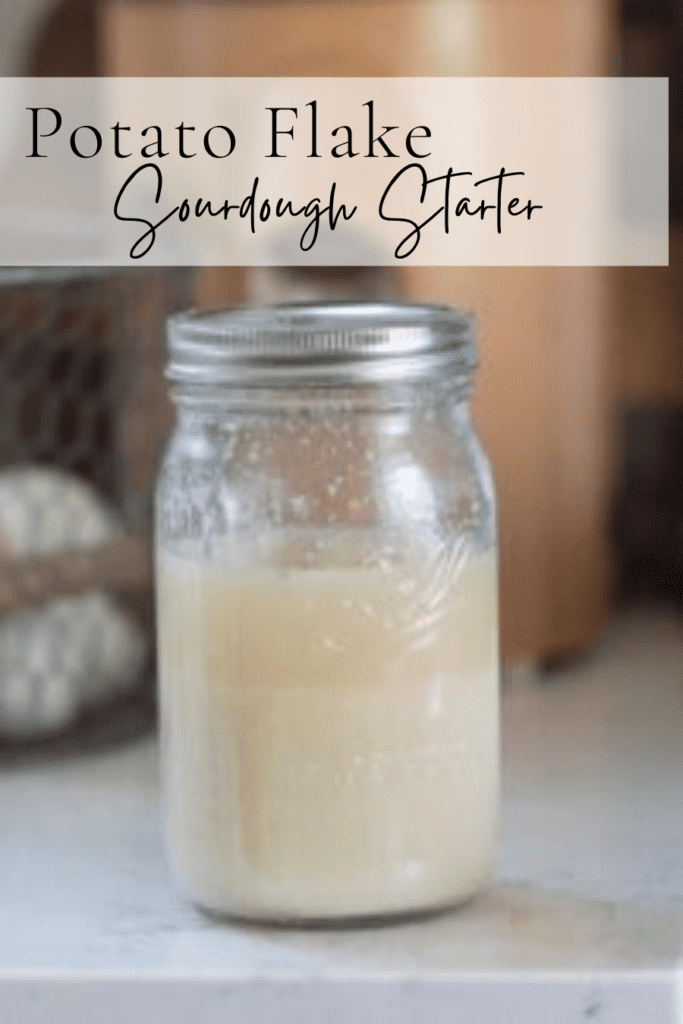
What is a potato flake sourdough starter?
A potato flake sourdough starter is made with dehydrated potato flakes, yeast, sugar, and water. When used in baking, it is what causes your bread to rise. It will give your baked goods a much sweeter taste than a traditional sourdough loaf. This starter is also gluten free and dairy free.
Note that not all yeast is gluten free. If you are strictly gluten free, you can reference this page to see what yeasts will work for you. A commercial yeast packet – active dry yeast or instant yeast – is typically considered gluten free.
This post contains affiliate links, which means I make a small commission at no extra cost to you. See my full disclosure here.
Why you’ll want a potato flake sourdough starter
A potato flake sourdough starter is fairly easy to maintain. Plus, this type of starter will result in a sweeter and less sour taste in your final product. I like it best in sandwich bread recipes or dinner rolls.
I’ve included a sourdough recipe below that is similar to my regular sandwich bread, but uses a potato flake starter instead!
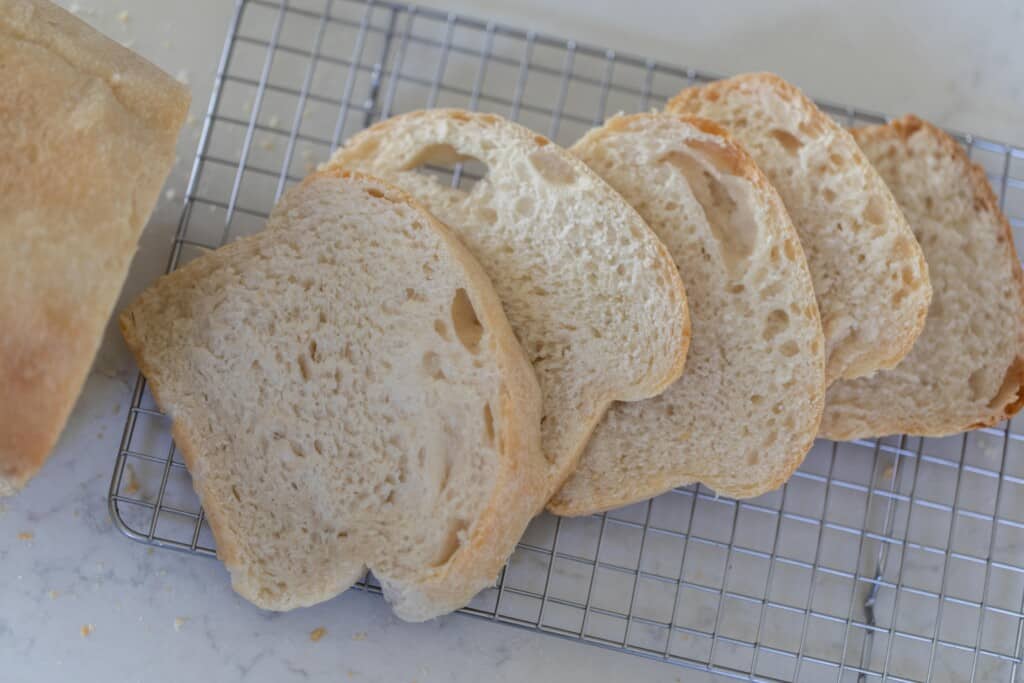
Tips for a sourdough bread starter with potato flakes
- Unlike your typical sourdough starter made with just flour and water, a potato flake starter will be a lot thinner. Of course, this will affect how much water you add to the recipe.
- If your potato flakes settle to the bottom – that is okay! It likely won’t stay incorporated, and that is normal. Simply give it a quick stir before use.
- Store your potato flake starter in the fridge. I try to feed it once a week to keep it thriving.
- If you do not want to make bread, you can discard one cup of the starter before feeding and use it in a sourdough discard recipe. My discard recipes call for traditional sourdough starter, but you can also use a potato flake starter instead. Check out some of those recipes here!
FAQ
A sourdough starter replaces the yeast in bread. It is the starter that allows bread to rise. Otherwise, your loaf would turn out flat and dense.
A traditional sourdough starter typically only uses flour and water to both create it and maintain it. A potato flake starter requires sugar, yeast, water, and potato flakes to get it started. To maintain it, you skip the yeast, but will still have to feed it sugar, water, and potato flakes! It tends to give breads a much sweeter taste than regular sourdough bread. If you’d like to learn how to make a traditional sourdough starter, click here!
It is sweeter and less sour.
Indefinitely, as long as you continue to maintain/feed it!
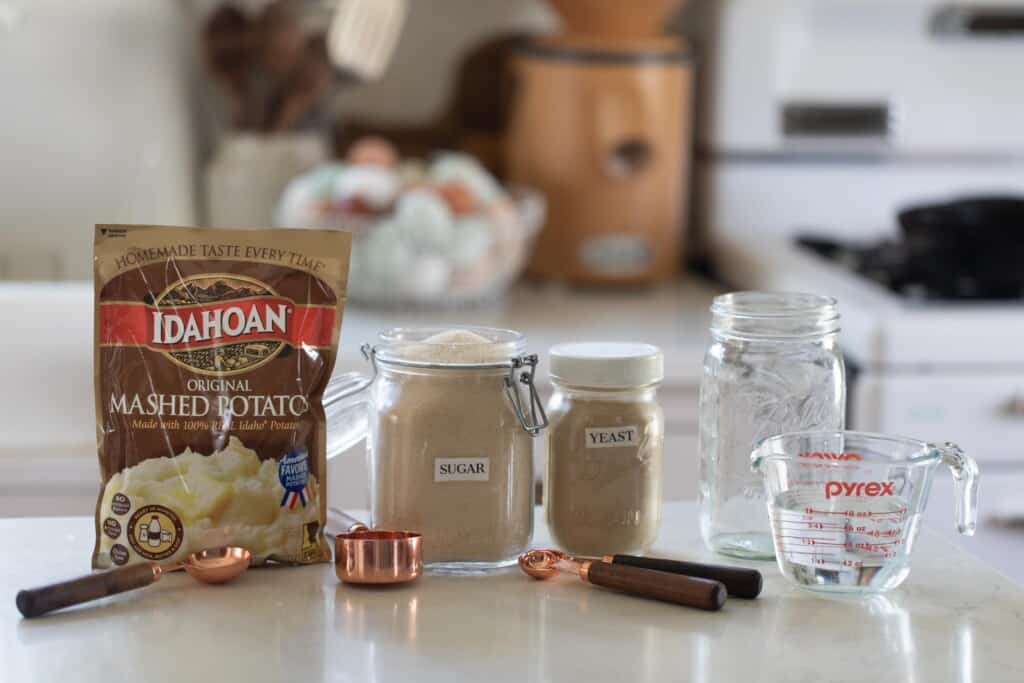
Potato Flake Starter Ingredients
This recipe will use potato flakes, sugar and commercial yeast to get it going. After it gets established, the wild yeasts will take over, and you will only have to feed it potato flakes, sugar and water.
1 cup warm water
1/4 cup sugar
1 package dry yeast (2 1/4 teaspoons)
3 tablespoons instant potato flakes
Tools to help you get started
Glass container/jar or large bowl
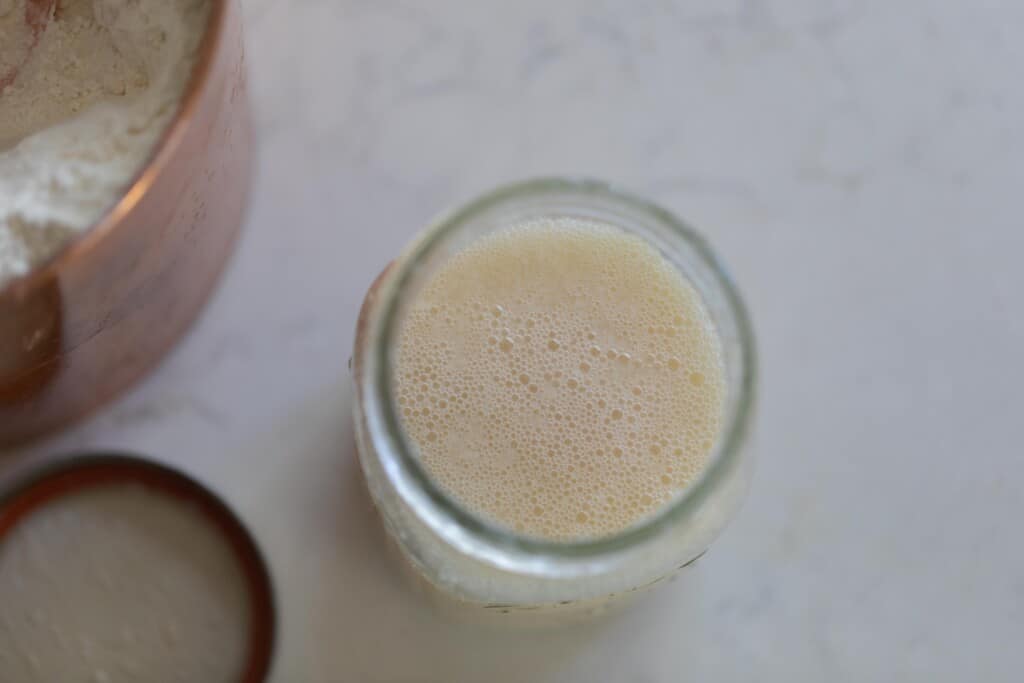
How to make a potato flake sourdough starter
- Start with a clean glass container or a large bowl.
- Add in the warm water, potato flakes, sugar and yeast.
- Stir everything together and scrape down the sides.
- Cover with something that is slightly breathable. You can use a tea towel or coffee filter with a rubber band. I like to use a flip top canister with the rubber gasket taken out or a glass jar with a glass lid. Both of these are not airtight, so the gasses (which are a natural bi product of fermentation) can escape.
- Leave it at room temperature for 4 days, stirring daily.
- On the 5th day, feed the starter with 1 cup warm water, 1/4 cup sugar and 3 tablespoons of instant potato flakes. Stir it well and allow it to sit at room temperature for 8 hours.
- Remove 1 cup of the starter to make your bread. Place the remaining starter in the refrigerator. (see instructions below to maintain for future use.)
How to maintain a potato flake sourdough starter
You maintain a potato flake sourdough starter a lot like you maintain a regular one, except you use different ingredients!
We used a package of commercial yeast to jumpstart this process originally, but you will not need it to maintain your starter.
Maintenance Ingredients
1 cup warm water
1/4 cup of sugar
3 tablespoons instant potato flakes
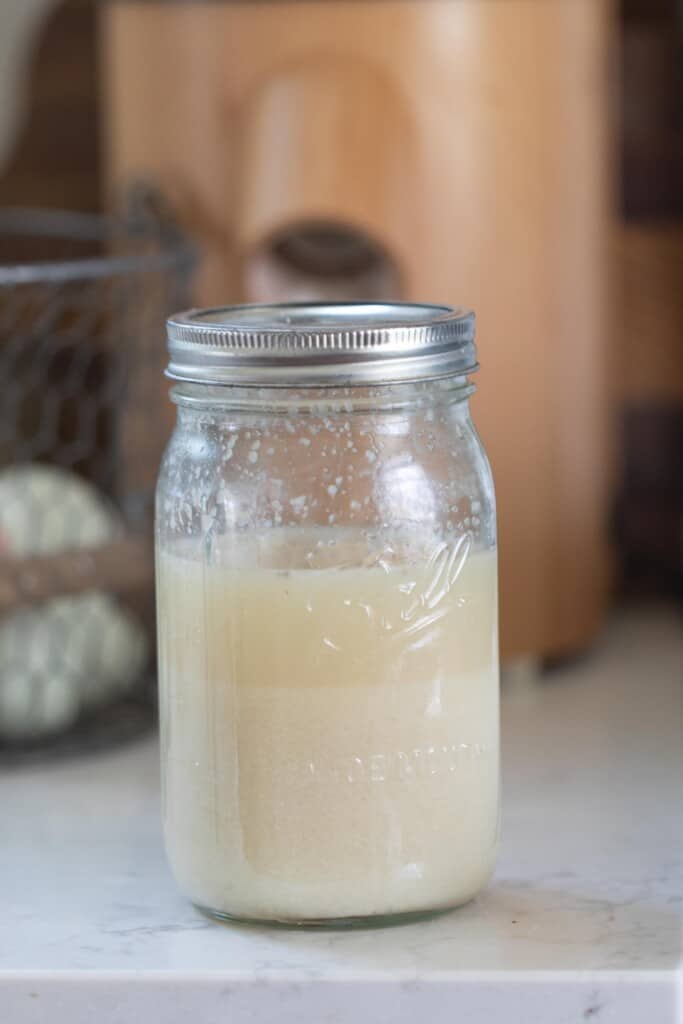
Step-by-step instructions for maintaining your starter
Remove your starter from the refrigerator, and feed it with 1 cup of warm water, 1/4 cup sugar and 3 tablespoons of instant potato flakes. Allow it to sit at room temperature for 6 hours, or until it looks bubbly and active.
Remove 1 cup of the starter to make potato flake sourdough starter bread. Put it back in the refrigerator until you want to repeat this process and make another loaf of bread.
Storing your potato flake starter in the refrigerator
Just like with a regular sourdough starter, you can store it in the refrigerator for several weeks in between uses, but it stays most active if you feed it regularly. Aim for once a week.
If you do not want to make bread, you can discard one cup of the starter before feeding and use it in a sourdough discard recipe. My discard recipes call for traditional sourdough starter, but you can also use a potato flake starter instead. Check out some sourdough discard recipes here.
How to use your potato flake sourdough starter to make bread
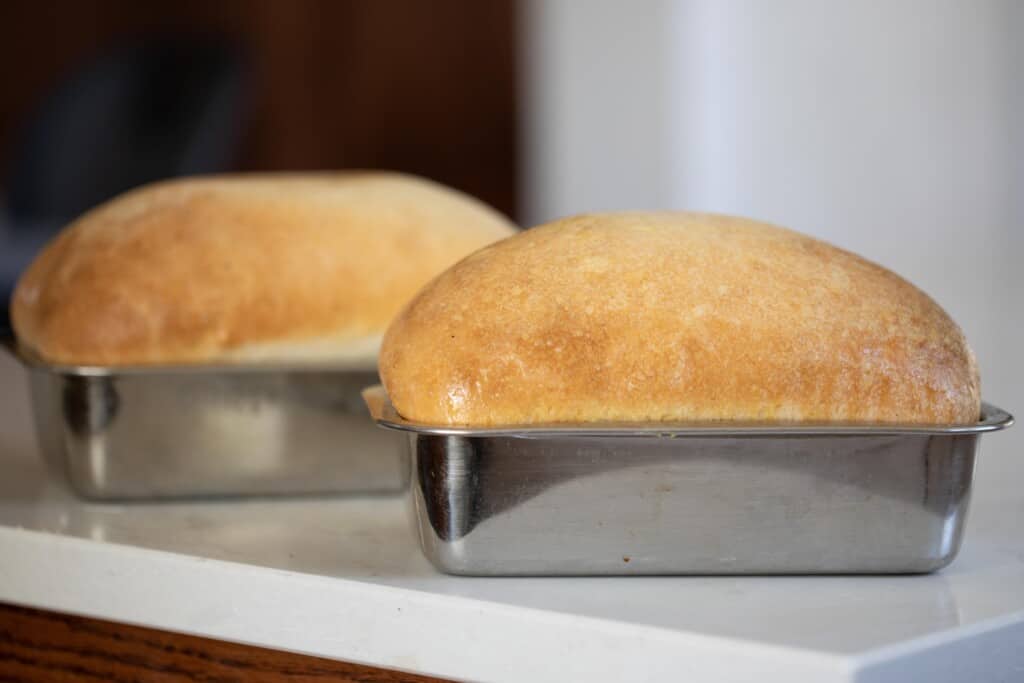
Ingredients
1/2 cup butter (softened) or coconut oil (113 g)– Use coconut oil if you are making this dairy-free or simply like more of a coconut taste.
1/2 cup sugar (96 grams)
1 tbs salt (17 grams) – I use a tablespoon salt, and prefer to use sea salt if possible!
1 cup potato flake sourdough starter (275 g), active and bubbly, active and bubbly
2 1/4 cups water (531 g)
8 cups all purpose flour (1200 g)
Tools you may need
Measuring cups and spoons (or a kitchen scale)
9.5 in by 5 in Loaf pans
Directions:
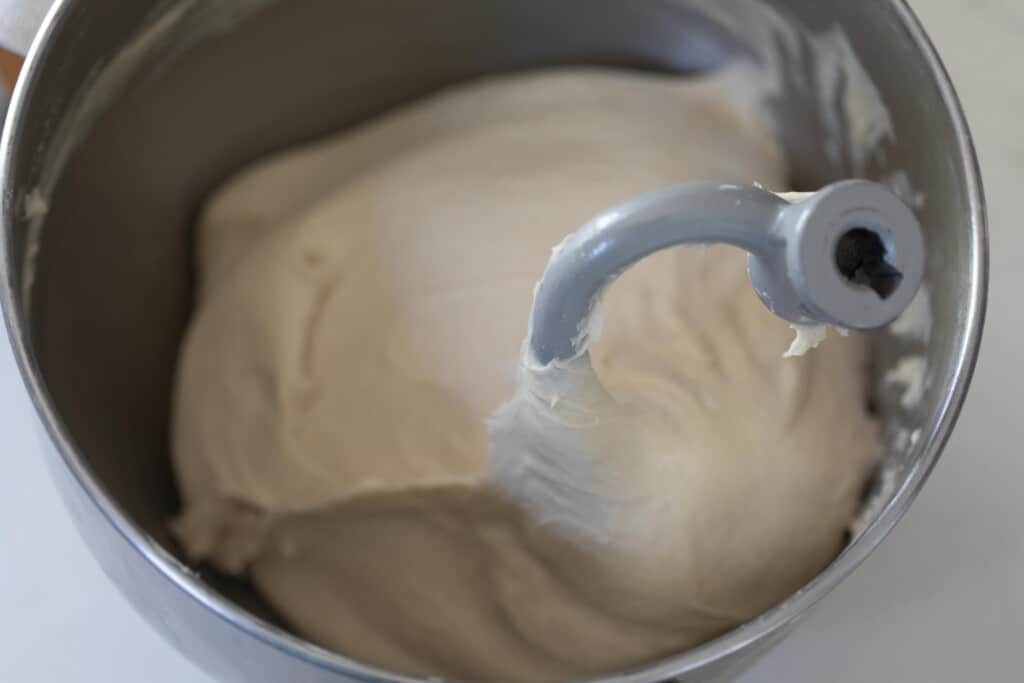
Mix ingredients
Add all of the ingredients to a stand mixer. I recommend adding the flour last. This way you can add more or less as needed, pending your starters hydration level.
Knead the dough
Turn on your stand mixer and knead the dough until it is stretchy and smooth. It will take about 10 minutes. When it is ready, it will pull away from the sides of the bowl and be elastic and smooth.
Make sure it passes the windowpane test! Grab a small ball of the dough and stretch it into a square. It should stretch thin enough to see through without breaking.
Bulk Rise
In a warm place, allow your dough ball to bulk rise for 10-12 hours. You can go longer if you want the benefit of the fermentation. However, don’t overproof! It will turn your dough into a sloppy mess.
Shape and rise
Prepare two loaf pans by either greasing them or adding pieces of parchment paper.
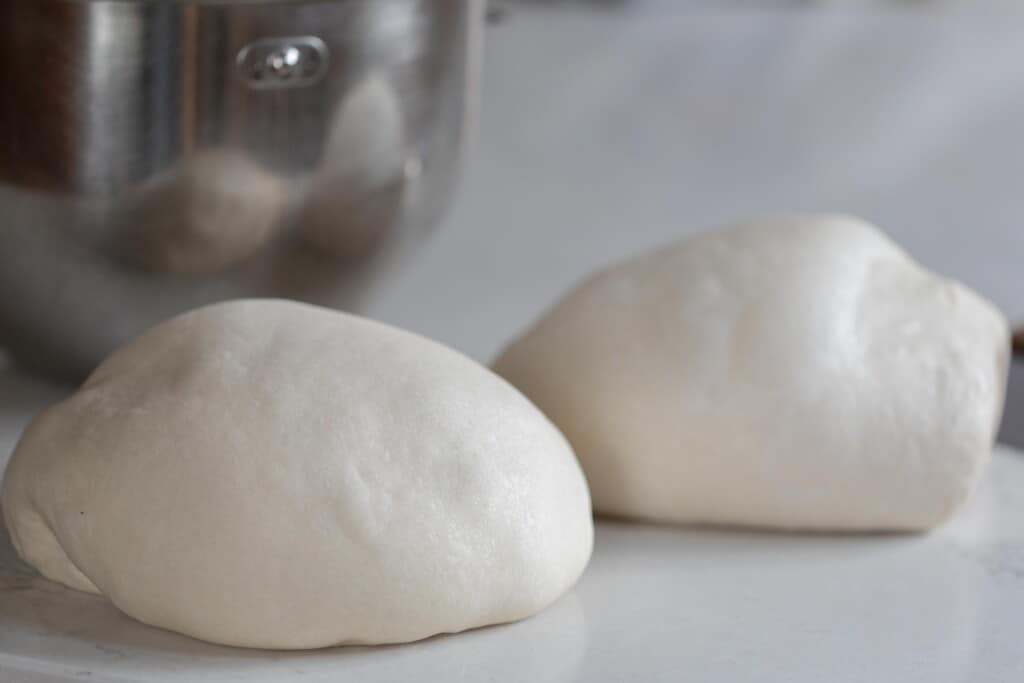
Divide dough into two equal parts.
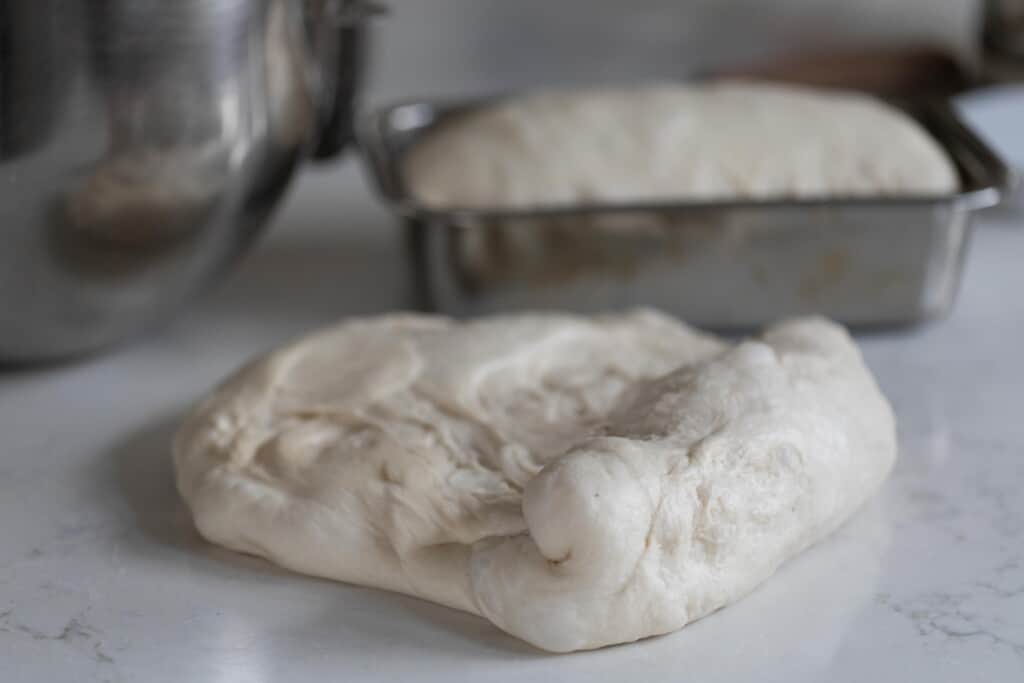
To shape your dough, roll it out flat into a rectangle and then roll it up.
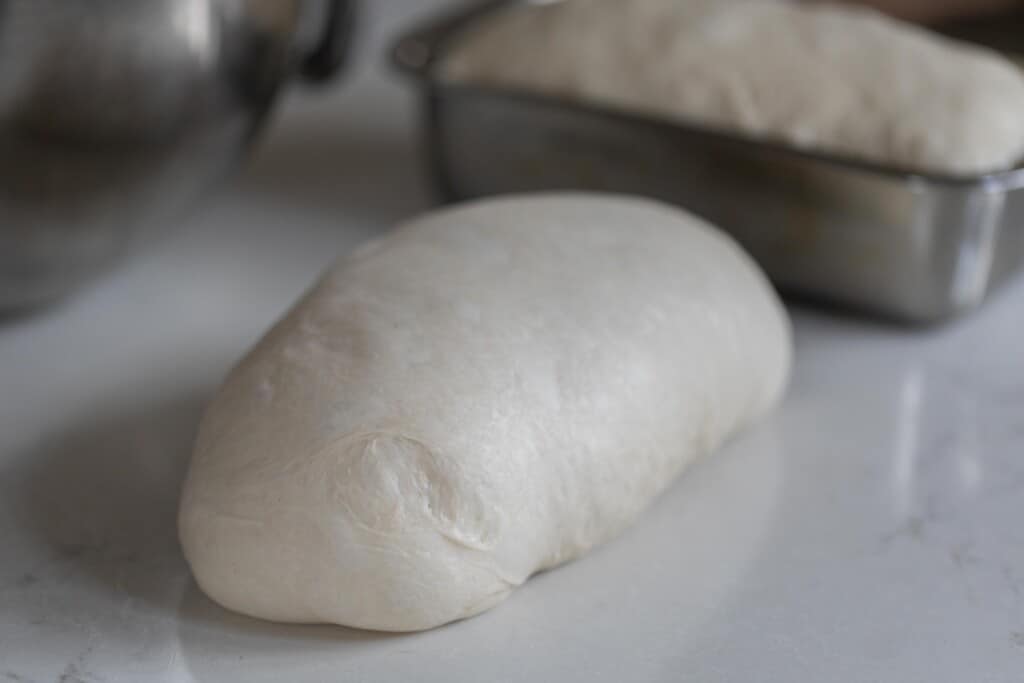
Allow to rise again for 2- 4 hours at room temperature or until doubled. The amount of time all depends on the temperature of your home.
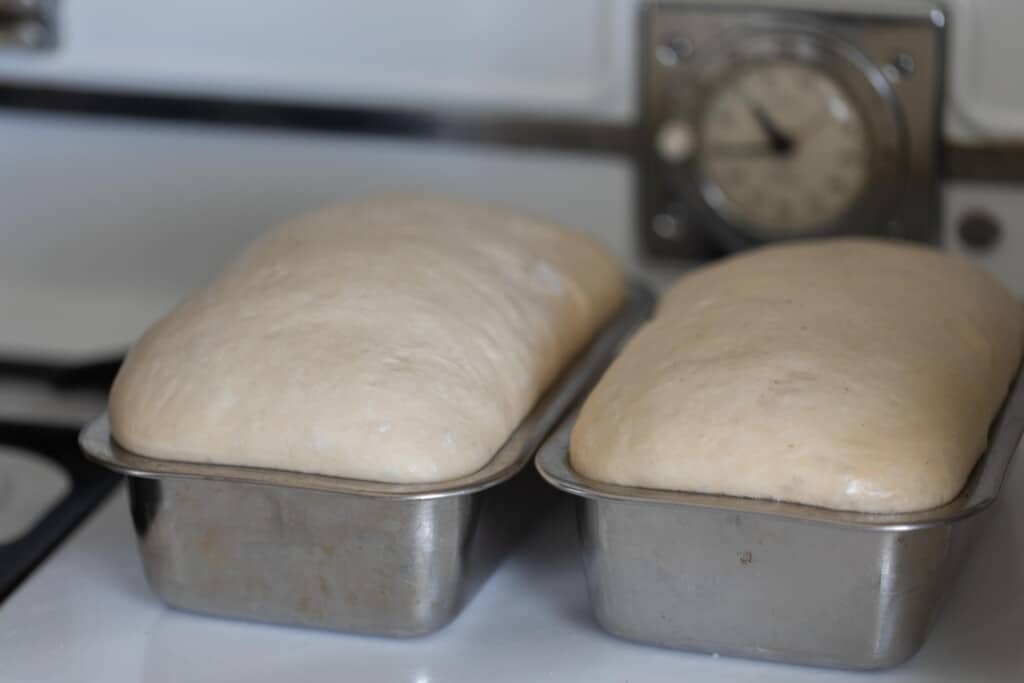
Bake
Optional: Add an egg wash on top of the loaves before baking. This provides more browning.
Bake at 375 for 45 minutes, or until golden on top.
Allow to cool completely before slicing.
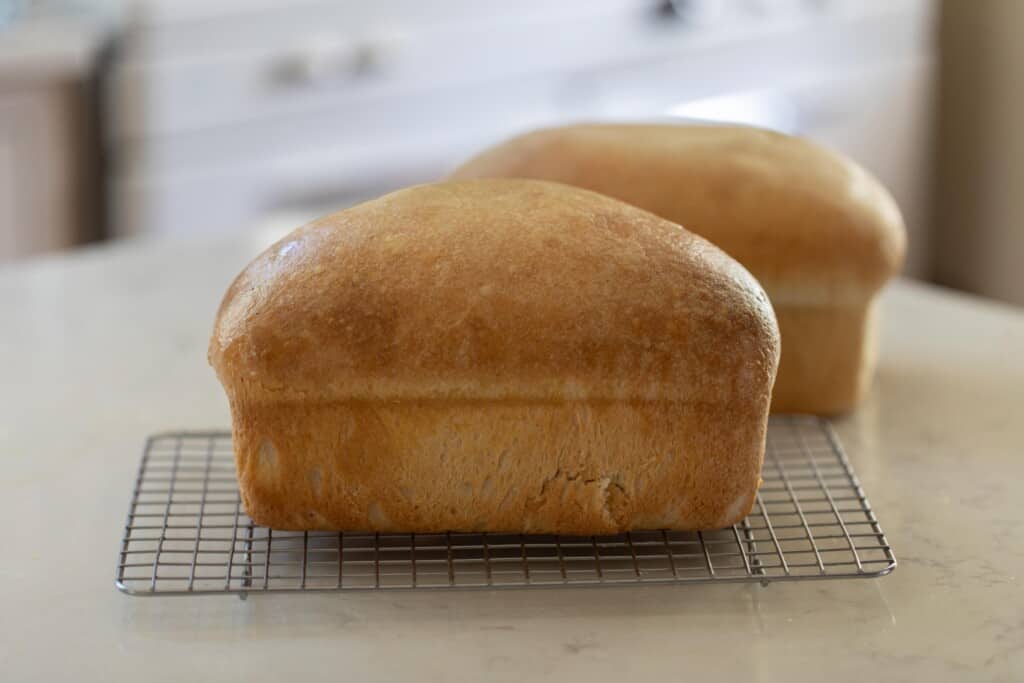
Check out more sourdough resources and recipes!
- Learn how to make a traditional sourdough starter
- How to maintain a traditional sourdough starter
- Gluten Free Sourdough Starter
- Sourdough Cinnamon Rolls
- Sourdough Dinner Rolls
If you try this recipe and love it, I would love it if you gave it 5 stars! Thank you! Tag me on Instagram @farmhouseonboone.
Potato Flake Sourdough Starter
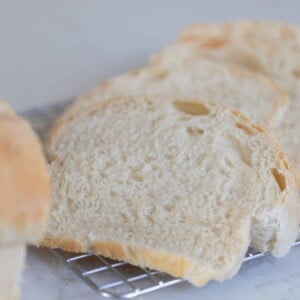
Ingredients
- 1 cup warm water
- 1/4 cup sugar
- 1 package dry yeast, 2 1/4 teaspoons
- 3 tablespoons instant potato flakes
Instructions
- Start with a clean glass container or a large bowl.
- Add in the warm water, potato flakes, sugar and yeast.
- Stir everything together and scrape down the sides.
- Cover with something that is slightly breathable. You can use a tea towel or coffee filter with a rubber band. I like to use a flip top canister with the rubber gasket taken out or a glass jar with a glass lid.
- Both of these are not airtight, so the gasses (which are a natural bi product of fermentation) can escape.
- Leave it at room temperature for 4 days, stirring daily.
- On the 5th day, feed the starter with 1 cup warm water, 1/4 cup sugar and 3 tablespoons of instant potato flakes. Stir it well and allow it to sit at room temperature for 8 hours.
- Remove 1 cup of the starter to make your bread. Place the remaining starter in the refrigerator.
Maintaining The Starter
- Remove your starter from the refrigerator, and feed it with 1 cup of warm water, 1/4 cup sugar and 3 tablespoons of instant potato flakes.
- Allow it to sit at room temperature for 6 hours, or until it looks bubbly and active.
- Once bubbly, it can be used in bread recipes.
- Keep stored in the fridge between uses. Feed every 3-5 days
Notes
Nutrition
Nutrition information is automatically calculated, so should only be used as an approximation.










So I followed the directions to the tee, but my starter isn’t bubbling. Could I possibly have a temperature issue? I kept it in my oven with the light on in hopes of maintaining the correct temperature. Any thoughts on what went wrong or how I can save it?
Could be. Was the water too hot potentially killing the yeast? Or was the yeast old?
I think maybe the water was too hot the first go round. I attempted to try again and my mixture bubbled within an hour, but then stopped bubbling about 2 days later. I fed it on the 5th day and it never bubbled or anything. Could my mixture be getting too warm in the oven (oven always remained off but I did have to cook on my stove) potentially killing it? I attempted to make another starter today and will leave it on the counter. Praying that I don’t kill this one!
Any advice you could offer would be amazing!
It could be affecting your starter if it’s getting too hot.
My mother had a potato flake starter when we were growing up and I have memories of the delicious rolls she made. I chose your starter recipe because it used quite a lot less sugar than the others. My first attempt at making your bread recipe (I halved the recipe in case it didn’t turn out) was a little concerning because there was way too much liquid and I had to keep adding flour. I probably had to add an extra 1.5 to 2 cups of flour. Fortunately, it turned out in the end (texture and taste were good) but I wound up with two smaller loaves. Next time I will cut way back on the additional water. I’m posting this so it may be helpful to others. Thank you for the starter recipe!
Hmm I wonder why there was such a discrepancy. Thanks for sharing your experience.
reading all these comments because I want to try your recipe. Mine calls for 3/4 cup of sugar when feeding the starter, but will do your way. But…when making the bread, I use oil, and that’s the reason I’m doing your recipe because I want to use the butter that yours calls for. The water content, yours calls for 2 1/4 cups and mine calls for 1 1/2 cups..and the post above where Jeanie had to use a lot more flour, I wonder if using the 1 1/2 cups water would be sufficient instead of the 2 1/4 cups.. going to try this when I hear back from you. Thanks
Is this type of bread lower in sodium than a lot of “traditional” breads?
Not sure. Haven’t really compared it.
My potato sourdough starter doesn’t appear to be active. I see no bubbles. I started it on Friday and at first it looked like it was bubbling, but not since. Can you help me troubleshoot it?
I would keep feeding it. Sometimes it can take awhile to get it to be active!
My bread isn’t done in the middle. What should I do?
Try cooking it a little longer!
The old recipe I have for Sour Dough Bread starter call for 3/4 cup of sugar, 3 T. Instant Potatoes and 1 cup of warm water, let this started set out of the frig for 8-12 hours mixture will be bubbly stir occasionally. By letting this set out would this starter replace the yeast. Thanks Nancy
The yeast is used to get it started. Once it is started, however, you only feed it the sugar, potato flakes, and warm water.
Hello! I just finished my second round of bread baking with this starter recipe. It is amazing and the directions are easy to follow. Thank you! Could you please share best practice on how to share this starter with a friend? Also, some sites suggested when feeding the starter to discard all but one cup before adding the feeding ingredients. Do I need to do this? Thanks so much for your help!
I’d suggest sharing the one cup of starter removed after you feed it (instead of making bread with it). I typically follow the instructions as I have them for feeding, but you should do what seems to work best for you and your starter. Hope that helps!
If I give a cup to my friend, what does she do to it to keep it going? Does she keep it out for the 4 days and then feed like normal? Then she can bake with it in the fifth day? I’m a little confused on when she would refrigerate it.
In the post there are directions on how to maintain the starter in the post. Refrigerate the starter when you aren’t planning to use it daily, and feed it once a week.
Do you have a sourdough bread recipe? That you can share. I’m just getting started.
you can search the blog for all my bread recipes. Here is one specific for beginners: https://www.farmhouseonboone.com/beginners-sourdough-bread-recipe There is also a sourdough bread that uses potato flake starter within this post. Good luck!
Can I make a gluten free bread using this starter?
Also can I put some whole wheat flour so it’s healthier?
Yes you can. This starter is also gluten free and dairy free. Note that not all yeast is gluten free, though. If you are strictly gluten free.
And you could replace some of the AP flour with whole wheat flour. It may make your final product a bit more dense.
Well that was QUICK ❤️ Thank you so much.
Do you have a special recipe for Gluten-free bread using this starter? Or,do you just follow the same recipe substituting Gluten-free for the bread flour?
Can you send me the GF recipe or tell me where to find it? Thank you again for responding so quickly. Marsha Taylor
Can you please send me the gluten free bread recipe I can use with this starter?
Thank you. I did download your ebook but it wasn’t in there. It was sourdough recipes.
Hi, do you ever do a discard with this recipe? If you do a discard do you take it before or after you feed it?
If you do not want to make bread, you can discard one cup of the starter before feeding and use it in a sourdough discard recipe.